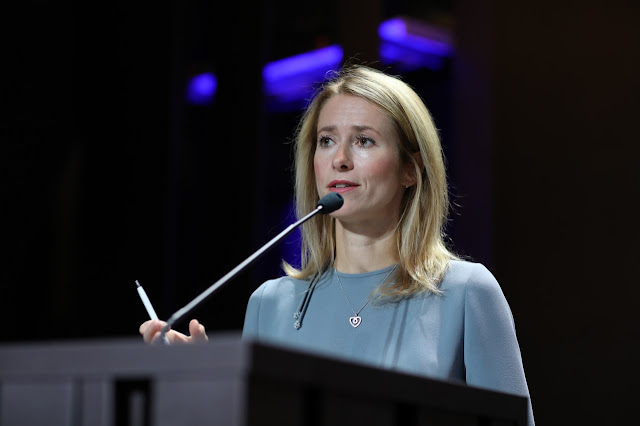Kaia Kanepi of Estonia
notched another upset in her lengthy career, claiming her 12th win over a Top
10 player with a 6-1, 2-6, 6-1 triumph over World No.7 Aryna Sabalenka of
Belarus at the Gippsland Trophy. "When
I play well and aggressive, I think it’s tough for anybody to beat me,"
Kanepi said in her post-match interview on court. Sabalenka had won her previous 15 matches,
which encompassed title runs at Ostrava and Linz in 2020 and Abu Dhabi to start
this season. Kanepi is World No.94
Kanepi, and at 35 is the oldest player in the Gippsland
Trophy draw this week, ousted then-World No.1 Simona Halep at the 2018 US Open
for her most recent Top 10 victory prior to today's victory.
Not a post on Kaia
Kanepi or Sports but something on women in power ! Estonia, a nation of 1.3 million, is now one
of the few countries where both the Head of State and the Head of Government
are women.
Estonia’s first female prime
minister has promised to implement changes in both style and substance in the
governance of the Baltic nation, as she takes charge after two years in which a
far-right party was in the ruling coalition. Kaja Kallas, a 43-year-old lawyer
and head of Estonia’s Reform party, was sworn into office on 26.1.2021. The previous coalition collapsed after a
corruption scandal involving the Centre party of Jüri Ratas, who resigned as
prime minister. He caused controversy after elections two years ago by going
into coalition with the far-right EKRE, whose members opposed all immigration,
were often Eurosceptic and on occasion praised Nazi economic policy !!
The Aesti were an ancient people first described by the
Roman historian Tacitus in his treatise Germania (circa 98 AD). The history of Estonia forms a part of the
history of Europe. Humans settled in the region of Estonia near the end of the
last glacial era, beginning from around 8500 BC. Before German crusaders
invaded in the early 13th century, perhaps their lives were much more peaceful. Starting with the Northern Crusades in the
Middle Ages, Estonia became a battleground for centuries where Denmark,
Germany, Russia, Sweden and Poland fought their many wars over controlling this geography.
After Danes and Germans conquered the area in 1227, Estonia was ruled initially by Denmark in the north, by the Livonian Order, an autonomous part of the Monastic state of the Teutonic Knights and by Baltic German ecclesiastical states of the Holy Roman Empire. Throughout this period the Baltic-German nobility enjoyed autonomy, and German served as the language of administration and education.
Estonia is a country on the eastern coast of the
Baltic Sea in Northern Europe. It is bordered to the north by the Gulf of
Finland across from Finland, to the west by the Baltic Sea across from Sweden,
to the south by Latvia, and to the east by Lake Peipus and Russia. Tallinn, the capital of Estonia, and Tartu are
the largest cities and urban areas in the country. Other notable cities include
Narva, Pärnu, Kohtla-Järve and Viljandi. The official language of the country,
Estonian, is the second-most-spoken Finnic language.
After centuries of successive rule by Germans, Danes, Swedes, Poles and Russians, a distinct Estonian national identity began to emerge in the 19th and early 20th centuries. This culminated in independence from Russia in 1920 after a brief War of Independence at the end of World War I, where Estonians, led by General Laidoner, had to fight for their newborn freedom. Initially democratic prior to the Great Depression, Estonia experienced authoritarian rule from 1934 during the Era of Silence. During World War II (1939–1945), Estonia was repeatedly contested and occupied by Germany and the Soviet Union, ultimately being incorporated into the latter as the Estonian Soviet Socialist Republic. After the loss of its de facto independence for the Soviet Union, Estonia's de jure state continuity was preserved by diplomatic representatives and the government-in-exile. In 1987 the peaceful Singing Revolution began against Soviet rule, resulting in the restoration of de facto independence on 20 August 1991.
The Prime Minister of Estonia is the head of government of the Republic of Estonia. The prime minister is nominated by the President after appropriate consultations with the parliamentary factions and confirmed by the Parliament. In case of disagreement, the Parliament can reject the President's nomination and choose their own candidate.
The
current Prime Minister is Kaja Kallas of the Reform Party. She took the office
on 26 January 2021. Unlike counterparts in other parliamentary republics, the
Prime Minister is both de jure and de facto chief executive. This is because
the Constitution explicitly vests executive power in the Government, of which
the Prime Minister is the leader.
Kaja Kallas (18 June 1977) has
become the first woman to serve in the position. She has been the leader of the
Reform Party since 2018, and a member of Riigikogu since 2019, and previously
from 2011 to 2014. Kallas served as member of the European Parliament from 2014
to 2018, representing the Alliance of Liberals and Democrats for Europe. Before
her election to parliament, she was an attorney specializing in European and
Estonian competition law. Jüri Ratas was the 18th Prime Minister of Estonia from
2016 to 2021. Jüri Ratas' second cabinet
was active from April 2019 to January 2021. It has been notable for its share
of public scandals, resignations of ministers and the number of public
apologies from Ratas. Ratas resigned as prime minister on 13 January 2021 after
the Prosecutor General suspected the Centre Party of "criminal
involvement" in an influence peddling scandal involving businessman Hillar
Teder.
Interesting !
With regards – S.
Sampathkumar
2.2.2021.


No comments:
Post a Comment